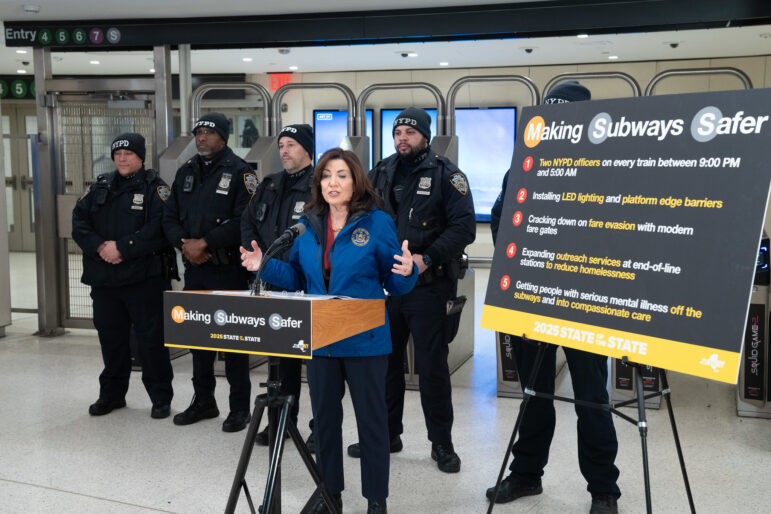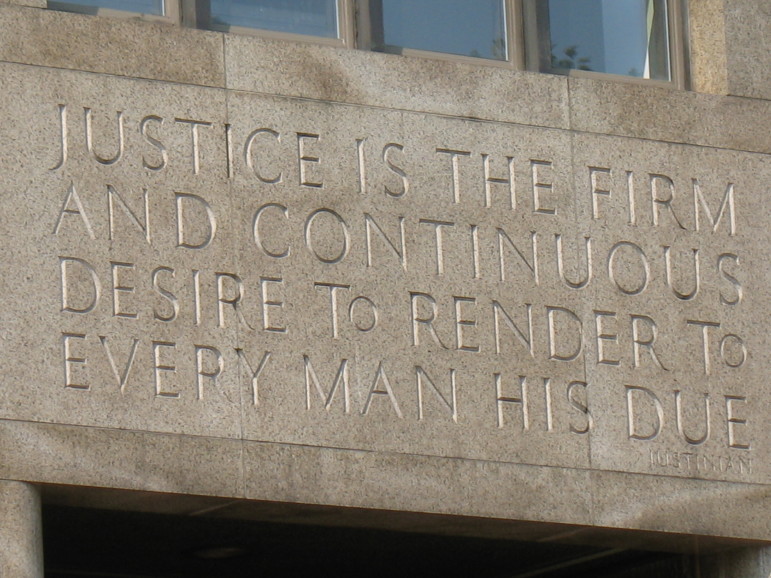
Adi Talwar
The urge to streamline community board meetings is understandable. But Florence Koulouris, manager for Queens Board 1, says that the meetings will always be complex since they involve volunteers from different backgrounds with busy lives.
On June 21, Queens Community Board 1, which represents Astoria, Woodside and Steinway among other neighborhoods, held its last monthly meeting before a two-month summer break. Representatives from the Department of Transportation addressed the board requesting a vote on a range of safety improvements, among them a proposed bike lane that would provide a link among major parks in Queens. The community board batted back and forth the details of the bike route. Many board members supported the lane but were concerned that the path was too dangerous. Others asked why bicyclists were not required to wear helmets, something outside the purview of DOT officials.
Finally, the board voted on an amendment to adjust the route of the bike lane but did not agree on whether to approve the overall project, a decision several members in attendance found confusing.
“I’m just not sure what it is we’re voting on,” said Evie Hantzopolous, an Astoria resident and board member.
Another attendee, James McIntyre, 36, a member of Queens Bike Initiative, the organization that originally proposed the connected bike lanes, suggested during an open comment period that by voting on a recommendation without voting to approve the bike route, the board had voted on nothing.
The issue was clarified after the fact in a letter to the DOT, and the board members’ many suggestions were streamlined, says Florence Koulouris, Queens Community Board 1’s District Manager.
“Sometimes it can be kind of messy. So I feel like we’re trying to work through those moments,” Hantzopolous, 51, says of the meetings.
In New York City, community boards are the first level of government that citizens have access to. The city’s 59 community boards hold influence, but not veto power, on matters such as liquor licenses, sidewalk cafes and land-use issues ranging from bike lanes to housing.
But recent ambitious, citywide projects like Vision Zero and the mayor’s affordable-housing plan have reignited long-standing critiques of community boards, raising questions about the value of their advisory votes and how effective they are at reflecting the will of the diverse community districts they represent.
Introduced citywide by Mayor Robert Wagner under the 1963 charter, the boards were later given power to provide recommendations on land use and the capital budget, part of Mayor John Lindsay’s plan to further decentralize city government. Each board has up to 50 unpaid board members appointed by the borough president, half of whom are nominated by their local City Council member.
Many of the boards now act as hubs where city agencies approach the public about upcoming projects, delivering powerpoint presentations and staying for sometimes fiery question-and-answer sessions. The process of getting projects approved is one that some board members complain is rushed. Simultaneously, critics believe the process can be an unnecessary hurdle to getting vital infrastructure green-lighted.
Another issue is that meetings at boards like Queens Community Board 1 can unnecessarily become bogged down in misunderstandings about process.
“Everyone on the community board, I think, is here because their heart’s in the right place,” says Hantzopolous, who lives in Astoria. “Sometimes it can be confusion in terms of what procedure is,” she adds.
McIntyre, a Jackson Heights homeowner, says these challenges can lead to inefficiencies at boards that encounter complex proposals and draw well-attended meetings like Queens Community Board 1, which had over 75 people gathered into a ballroom in Astoria World Manor for its final meeting before the summer recess.
“How do you have a cohesive form of government that also reflects the community and doesn’t get bogged in procedural issues?” McIntyre asks, adding that board meetings can become convoluted and what’s being voted on isn’t always clear. “I’ve seen it a couple times, people not understanding what they’re voting on. The challenge becomes when more complex problems are addressed. It gets very muddled and there’s a lack of cohesion.”
McIntyre, who works at a startup that crowdfunds civic projects, says that there could be more streamlined methods of generating consensus within the community. “Community boards and the DOT sit on opposite sides of the table. Everyone thinks it’s one versus the other, but we as the community should look at how everyone comes together,” McIntyre says.
One issue that adds to the confusion is a communication gap between city agencies, who have to explain complex projects to the public, and board members, who must parse civic-planning jargon to understand how new projects will impact them. A solution to this would be for each board to have professional planning staff, something envisioned by the city charter but very rarely achieved in practice. Councilmember Ben Kallos introduced a bill in March 2015 requiring the appointment of at least one planner for every four community boards. The bill has yet to go to a vote.
Votes, or vetoes?
But some activists believe the problem with community boards isn’t procedure but power: They feel the purely advisory votes that boards have aren’t sufficient to protect their communities from unwanted projects. Brooklyn Anti-Gentrification Network, an organization opposed to the mayor’s affordable housing plan, was angered over the mayor’s decision to move forward with the mandatory inclusionary zoning (MIH) and zoning for quality and affordability (ZQA) changes to the zoning code despite broad opposition from community boards, who felt the measures were too generous to developers. The Network is calling for a revision to the City Charter to give the boards more authority. The group also wants community-board members to be elected rather than appointed by borough presidents.
Alicia Boyd, a member of BAN, is a lifelong Brooklyn resident and former Kindergarten teacher. She argues that community boards are intentionally disempowered by City Hall.
“The local political structure wants community boards to be non-functioning so that when they want something from the community board, it’s easy to get,” Boyd says.
Boyd also says the city’s Uniform Land Use Review Procedure, a system that allows for advice and recommendations from community members and multiple city agencies, is ineffective.
“It’s just rubber-stamping, it means nothing. Every study that the [Department of City Planning or DCP] creates, the DCP passes,” Boyd says. She believes that the real power community boards have is in the earliest stages of the development process, when the board can stall projects or stop studies from taking place.
Some district managers believe that the boards’ influence has been waning over the years. Jonathan Gaska, the district manager of Queens Community Board 14, which covers the Rockaways, says he and other district managers often complain when they see one another about the erosion of respect for community boards from the city.
“No one knows the community better than the people that live there,” Gaska says. “But unfortunately, over the last couple of administrations, they don’t seem to think that. They seem to think that they know better. And that’s been a disturbing trend that’s been continuing, quite frankly.”
While city agencies vary in how they deal with the boards—Gaska says the Parks Department has been particularly forthcoming and helpful—he says that the agencies typically just get in and get out as quickly as they can, fulfilling their obligation to inform the boards about new projects.
A commission appointed to revise the city charter in 2010 considered the issue of whether community boards should have more power in the Uniform Land Use Review Procedure, as well as other proposed reforms, including a more formal application process for member. But the commission recommended no changes, designating the question of community board powers as an issue for future consideration.
Some, however, prefer the current system, under which boards can be overruled. In Queens Community Board 4, the mayor’s reluctance to heed the advice of the community board, who recommended against a bike lane in the Elmhurst portion of Queens Boulevard, was lauded by transportation activists.
The proposed 1.2-mile bike lane between 74th Street and Elliot Avenue, part of a safety overhaul of the entire 7.2-mile Queens Boulevard, would run through three different Queens community districts; eliminating the Community Board 4 portion would have created a large gap. The arguments against the bike lane ranged from flimsy to odd: A member of Queens CB4’s transportation committee said in one meeting that empowering bicyclists would be troubling because they aren’t required to pay insurance and suggested that bicyclists are likely to steal pocketbooks. After months of debate with local bike advocates, the community board voted in support of the overall safety improvements, with the caveat that they did not support the bike lane. De Blasio signaled he would go forward with the bike lane anyway and it is scheduled to be implemented this summer.
Other paths to power
Others note that the boards’ lack of official power doesn’t mean they don’t have symbolic heft. Jaime Moncayo, Queens Community Organizer for Transportation Alternatives, says that it’s unusual for the mayor to go against community boards when it comes to ambitious infrastructure projects like the safety overhaul of Queens Boulevard.
Moncayo says that the city and local politicians care a great deal about boards’ input and approval, which can be a double-edged sword.
“When the community board does their job right, they provide valuable information to the city,” Moncayo says. But boards don’t always serve what some see as the interests of the communities they represent, Moncayo says, citing the opposition to the Queens Boulevard bike lane.
Community board votes can influence negotiations between local lawmakers and city agencies. By the time a deal was finalized for de Blasio’s MIH and ZQA policies, broad disapproval by community boards had led the City Council to negotiate a plan with more support among housing advocates.
Joseph P. Viteritti, chair of the Urban Policy and Planning Department of Hunter College, says that community boards were always advisory by design and, historically, there hasn’t been a groundswell of support for changing that. Viteritti says that conversations about giving boards veto power neglect other potential solutions, including ones that gives the board stronger power without having a full veto.
“When the conversation takes place, it’s a question of whether the board should have veto power over things. You could have a provision in which a community board votes something down, it requires a supermajority of the Council or [Planning] Commission to vote it down,” Viteritti suggests. “Nobody talks about it in those terms. There’s a very absolutist conversation about whether the board should have advisory or discretionary power,” he says.
Back at Queens Board 1, Koulouris says that community board meetings will always be complex by their nature, as they are staffed by volunteers from different backgrounds with busy lives.
“You have 48 different people from different walks of life, who walk away from their wife, their mother, their children, their boyfriend, their girlfriend—anything they do in their personal life—once a month, every month to come to a board meeting,” Koulouris says.
“These are people, whether you like their opinions or you don’t, they’re dedicated to their community. You don’t have to agree. You have to agree to disagree,” she says.
Read the rest of the series here.
* * *
City Limits’ coverage of housing policy is supported by the New York Community Trust and the Revson Foundation









One thought on “Do New York’s Community Boards Need Veto Power?”
Pingback: Community Boards Face Questions Over Demographics | City Limits